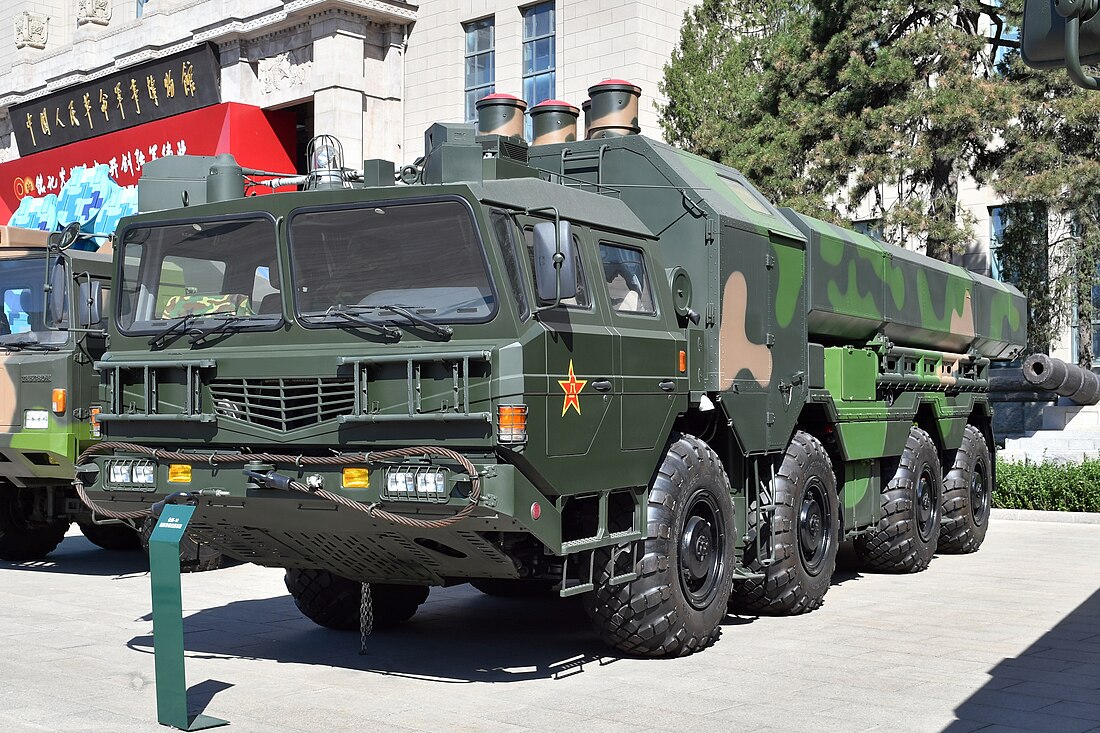CJ-10 (missile)
Chinese cruise missile From Wikipedia, the free encyclopedia
The CJ-10 (simplified Chinese: 长剑-10; traditional Chinese: 長劍-10; pinyin: Cháng Jiàn 10; lit. 'long sword 10') is a second-generation[1] Chinese land-attack cruise missile.[4] It is derived from the Kh-55 missile.[5] It is reportedly manufactured by the China Aerospace Science and Industry Corporation Third Academy and the China Haiying Electro-Mechanical Technology Academy.[1]
| CJ-10 | |
|---|---|
 CJ-10 Cruise missile on WS2400 TEL | |
| Type | Cruise missile Land-attack missile Air-launched cruise missile Anti-ship missile Submarine-launched cruise missile |
| Place of origin | China |
| Service history | |
| Used by | China |
| Production history | |
| Manufacturer | China Aerospace Science and Industry Corporation/China Haiying Electro-Mechanical Technology Academy |
| Specifications | |
| Warhead | 500 kg (1,100 lb),[1] conventional or nuclear[2] |
Operational range | >1,500–2,000 km (930–1,240 mi; 810–1,080 nmi) |
Guidance system | |
Launch platform |
|
Initially, the CJ-10 was identified as the DH-10 (Chinese: 东海-10; pinyin: Dong Hai 10; lit. 'east sea 10') by Western media and analysts.[6][7] United States Department of Defense reports used "DH-10" until 2011,[8][9] and then "CJ-10" from 2012.[10][11] Publications may use both terms interchangeably.[1][12] The Center for Strategic and International Studies believes that the CJ-10 is a member of the Hongniao (HN) series of missiles;[13] Ian Easton believes that the CJ-10 is the same missile as the HN-2, and that the HN-3 is the "DH-10A".[14]
Description
In the September 2014 edition of Joint Forces Quarterly, an article reportedly described CJ-10 as a subsonic missile with a range of more than 1,500 km and a 500 kg payload. The article attributes the missile having a guidance package using inertial navigation system, satellite navigation, terrain contour matching, and a likely Digital Scene-Mapping Area Correlator for terminal guidance. Ships and transporter erector launchers were listed as launch platforms.[1]
In 2013, the United States believes that the missile has a range of more than 1,500 km, and can potentially carry either conventional or nuclear payloads.[2] In 2004, the CJ-10 was credited with a CEP of 10 m.[15]
The YJ-100 is a subsonic anti-ship version of the CJ-10 with a range of 800 km (500 mi; 430 nmi). The missile can be air-launched by the H-6 bomber and fired from a vertical launching system of the Type 055 destroyer according to Chinese expert Li Li on Chinese television.[16] The YJ-100 will have an onboard radar.[17]
Development
The development of the CJ-10 could have potentially benefited significantly from Chinese acquisition of NATO and Soviet missile technology in the 1990s, notably the Kh-55 (purchased from Ukraine), and the Tomahawk cruise missiles (that were unexploded and purchased from Iraq and Serbia).[14] A 1995 Russian document suggested a complete production facility had been transferred to Shanghai, for the development of a nuclear-armed cruise missile. Originally it was thought that this was based on the 300 km-range Raduga Kh-15 (AS-16 'Kickback'), but it now appears that it was the Kh-55 that was transferred to China.[5]
Jane's Information Group reported the CJ-10 was tested 2004.[15] An August 2012 report by Jane's indicated that a shipborne variant of the missile may have been tested on Bi Sheng, a Chinese weapons trial ship.[18]
The United States in 2008 estimated that 50–250 missiles were in service,[19] increasing to 150–350 in 2009.[20]
Variants
- CJ-10 (DF-10)
- Baseline version. Known as DH-10 during the prototype phase.[21] Sometimes called the DF-10.[21]
- CJ-10A (DF-10A)
- Land-attack cruise missile.[22] Reportedly a stealthier, more accurate, version of the CJ-10.[14]
- "DH-2000"
- Supposedly a supersonic version of the DH-10A.[23]
- CJ-10K
- Air-launched version with a 1500 km range; may be carried by the Xian H-6K.[22]
- CJ-20
- Air-launched version of the CJ-10[24] with an estimated range of more than 2,000 km (1,200 mi; 1,100 nmi).[25] Reportedly been tested on the Xian H-6; each bomber may carry four missiles externally.[26]
- YJ-100
- Anti-ship version with an 800 km (500 mi)[17] or 1,000–1,500 km (620–930 mi) range,[1] launched by H-6 bomber and Type 055 destroyer.[16][17] Air-launched YJ-100[27] and CJ-10K[1] are both referred as KD-20 in separate sources.
Operators
 China
China
 People's Liberation Army Rocket Force: 200–500 CJ-10 (est. as of December 2009[update])[28]
People's Liberation Army Rocket Force: 200–500 CJ-10 (est. as of December 2009[update])[28] People's Liberation Army Air Force[29]
People's Liberation Army Air Force[29] People's Liberation Army Navy
People's Liberation Army Navy
See also
References
External links
Wikiwand - on
Seamless Wikipedia browsing. On steroids.
